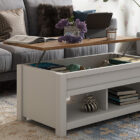Here are the eight essentials to strike the right chord with transitional interior design
Ever feel like your home is having an identity crisis, stuck between grandma’s antique charm and modern minimalism? Enter transitional interior design—the ultimate style therapist. This conceptual interior design skillfully combines traditional elegance with contemporary simplicity, creating spaces that are both timeless and stylish.
By blending classic elements with modern touches, this versatile style ensures your home feels cohesive, comfortable, and effortlessly beautiful. Whether you are updating a single room or your entire home, the transitional interior offers a harmonious balance that stands the test of time. Don’t believe us? Check out our top eight that will have you in awe. Read on!
1. A Transitional Style Interior Design in a Neutral Colour Palette
A foundational element of transitional interior design is a neutral colour palette. Shades of beige, grey, taupe, and white form the backdrop, providing a serene and sophisticated canvas that allows other design elements to stand out. These colours create calming vibes and make the space feel more open and airier.
Use varying shades of the same colour to add depth and interest. Incorporate textures like linen, silk, and velvet to enhance the visual appeal. Add pops of colour through accessories like pillows, rugs, and artwork to keep the space from feeling monotonous.

2. Transitional Furniture Style is the Best of Both Worlds
Transitional furniture style combines the clean lines of contemporary pieces with the more ornate details of traditional furniture. The result is a balanced look that feels both fresh and classic. Choose furniture with simple, understated shapes and soft, inviting fabrics to create a comfortable yet stylish environment.
The classics of this concept are a mix of straight and curved lines, upholstered pieces in neutral tones with subtle patterns, and wood finishes in both light and dark shades.

3. Statement Lighting in Transitional Interior Design Bedroom
Lighting is crucial in transitional concept interior design for bedrooms, providing both functionality and aesthetic appeal. Choose statement fixtures that blend modern and traditional elements, such as chandeliers with sleek designs or pendant lights with intricate details.
You can use a large chandelier as the beauty spot for your bedroom. Combine it with table lamps and floor lamps, which could be made of materials like glass, metal, or fabric. Ensure adequate task lighting in areas like the kitchen and home office.

Also, check out Traditional Interior Design Ideas
4. Transitional Contemporary Interior Design Values Textures And Materials
Transitional eclectic interior design thrives on the interplay of different textures and materials. Combining elements like wood, metal, glass, and fabric creates a dynamic, layered look that adds warmth and interest to your space.
Pair a wooden coffee table with a metal-framed mirror. Use plush throw blankets and cushions on a sleek leather sofa. Include woven baskets and glass vases for a touch of organic elegance.

5. Add Quirk to Transitional Interior Design With Art & Accessories
Art and accessories are essential for adding personality and character to your home. Choose pieces that reflect your taste and complement the overall design scheme. Transitional interior design ideas often include a mix of contemporary and traditional art, creating a balanced and cohesive look.
Display a mix of abstract and classic artworks. Use decorative items like vases, sculptures, and books to add layers of interest. Add plants and flowers to bring life and colour into the space.

6. Cosy Textiles In Transitional Style in Interior Design
Textiles play a significant role in interior design, adding comfort and warmth to your home. Choose high-quality fabrics for your curtains, rugs, and upholstery to create a luxurious and inviting atmosphere.
Use plush area rugs to anchor your furniture arrangements. Go for curtains made of natural materials like linen or cotton. Layer different textiles, such as silk cushions and wool throws, to add depth and texture.

7. Stylish Storage Enhances Transitional Concept Interior Design
Practical storage solutions are a must in any transitional interior. Look for furniture pieces that offer both style and functionality, helping you keep your space organized without sacrificing aesthetics.
Choose ottomans and benches with hidden storage. Include built-in shelves and cabinetry with clean lines. Use decorative boxes and baskets to keep smaller items tidy.

8. Transitional Interior Design Ideas Celebrate Balance And Harmony
The essence of transitional style interior design lies in its balanced and harmonious approach. Each element should complement the others, creating a cohesive look that feels effortless and natural. Symmetry is key – arrange furniture and accessories in pairs or evenly spaced groups. Mix traditional and contemporary elements in equal measure. Keep the overall design uncluttered and streamlined.

From vintage enthusiasts to contemporary fans, transitional style in interior design wows everyone. Ready to transform your home into a timeless masterpiece? Carefully select the best transitional designs for your living room, bedroom, kitchen and every nook of your space. Enjoy the perfect blend of classic charm and modern flair. Need help to start your home makeover? Our design specialists are eagerly waiting for you. Reach out: Contact Us | Home Interior Design | DesignCafe
FAQs
1. What is transitional design in interior?
Transitional design in interior combines traditional and contemporary elements, creating a balanced, timeless look. It blends classic styles with modern simplicity, resulting in elegant and functional spaces. This style emphasizes clean lines, neutral colours, and a mix of textures and materials, making it adaptable and appealing.
2. What are transitional interior design characteristics?
Transitional interior design characteristics include a neutral colour palette, a mix of traditional and contemporary furniture, clean lines, minimalistic accessories, and a blend of textures and materials. This style emphasizes balance and harmony, creating spaces that are both sophisticated and comfortable with a timeless and cohesive aesthetic.
3. What are the colors for transitional design style?
The colours for transitional design style are predominantly neutral, including shades of beige, grey, taupe, and white. These tones create a calming and sophisticated backdrop, allowing for subtle accents and textures. Occasionally, muted blues, greens, or soft pastels are added to enhance the overall palette.
4. What is the difference between transitional and traditional interior design?
The difference between transitional and traditional interior design lies in their approach and aesthetics. Traditional design focuses on classic, ornate details and rich colours, while transitional design blends these elements with contemporary simplicity and clean lines. Transitional design is more streamlined and neutral, offering a balanced, updated look.














